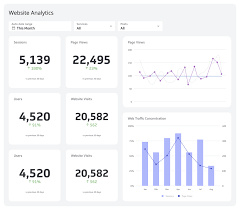
In the fast-paced digital landscape, understanding the performance of your website is crucial for making informed business decisions. This is where web analytics and reporting come into play, providing valuable insights into user behaviour, website traffic, and overall online performance.
Web analytics involves the collection, measurement, analysis, and reporting of web data to understand and optimise web usage. By tracking key metrics such as page views, bounce rates, conversion rates, and user demographics, businesses can gain a deeper understanding of how users interact with their website.
Web analytics empowers businesses to:
Reporting in web analytics involves transforming raw data into actionable insights through visualisations such as charts, graphs, and dashboards. Reports provide a comprehensive overview of website performance over time, highlighting trends, patterns, and areas that require attention.
Some essential metrics to monitor in web analytics reporting include:
Web analytics and reporting offer the invaluable advantage of providing businesses with deep insights into user behaviour and preferences. By analysing data on how users interact with a website, businesses can understand what drives user engagement, what content resonates with their audience, and where improvements can be made to enhance the overall user experience. This knowledge allows businesses to tailor their strategies to better meet the needs and preferences of their target audience, ultimately leading to increased customer satisfaction and improved conversion rates.
Web analytics and reporting offer the invaluable benefit of measuring the effectiveness of marketing campaigns. By tracking metrics such as click-through rates, conversion rates, and user engagement, businesses can gain insights into which marketing strategies are yielding the best results. This data allows companies to refine their campaigns, allocate resources more effectively, and ultimately maximise their return on investment. Web analytics empowers businesses to make data-driven decisions that drive success in an increasingly competitive digital landscape.
By utilising web analytics and reporting, businesses can optimise their website performance to enhance user experience and ultimately drive increased conversions. By analysing user behaviour, identifying bottlenecks in the conversion funnel, and testing different strategies, organisations can make data-driven decisions to improve website functionality and content. This proactive approach not only boosts user engagement but also maximises the likelihood of visitors taking desired actions, such as making a purchase or submitting a form. Through continuous monitoring and adjustment based on analytical insights, businesses can create a more efficient and conversion-focused online presence.
Web analytics and reporting offer businesses the invaluable advantage of identifying areas for improvement and uncovering growth opportunities. By analysing user behaviour, traffic patterns, and engagement metrics, companies can pinpoint underperforming aspects of their website and strategize ways to enhance them. Moreover, through detailed reporting, businesses can uncover trends and insights that reveal untapped potential for expansion and development. This proactive approach enables organisations to make data-driven decisions that propel them towards sustainable growth and success in the competitive digital landscape.
By utilising web analytics and reporting, businesses can make data-driven decisions to propel their success. By analysing key metrics and trends, companies can gain valuable insights into customer behaviour, preferences, and interactions with their website. This data empowers businesses to identify areas for improvement, optimise marketing strategies, and enhance user experience to ultimately drive business growth and achieve greater success.
One significant advantage of web analytics and reporting is the ability to track key metrics to monitor progress and success. By continuously monitoring essential indicators such as website traffic, user engagement, conversion rates, and goal achievements, businesses can gauge their performance accurately. This tracking enables them to identify areas of improvement, measure the effectiveness of marketing strategies, and make data-driven decisions to enhance overall success in the digital realm.
One significant drawback of web analytics and reporting is the inherent complexity of many tools in this field. Setting up and utilising web analytics tools can be a challenging task, especially for beginners who may encounter a steep learning curve. The intricate features and technical aspects of these tools often demand time and effort to grasp fully, potentially hindering quick and efficient implementation for those new to the field. This complexity can act as a barrier to entry, deterring some users from harnessing the full potential of web analytics for their websites.
One significant drawback of web analytics and reporting is the challenge of data overload. With an abundance of data at their disposal, businesses may find themselves overwhelmed by the sheer volume of information, making it difficult to extract meaningful and actionable insights from web analytics reports. This can lead to decision-making paralysis and hinder the ability to effectively leverage data for strategic decision-making and business growth. Striking a balance between collecting relevant data and analysing it effectively is essential to avoid getting lost in the sea of information that web analytics can provide.
Privacy concerns are a significant con associated with web analytics and reporting. The collection of user data for analytical purposes can raise red flags regarding privacy infringement and compliance challenges, particularly in light of regulations such as the General Data Protection Regulation (GDPR). Businesses must navigate the delicate balance between gathering valuable insights from user data and respecting individuals’ right to privacy, ensuring that they adhere to stringent data protection laws to maintain trust and transparency with their audience.
One notable drawback of web analytics and reporting is the cost associated with acquiring high-quality tools. Many advanced analytics platforms come at a substantial price, posing a challenge for small businesses operating on limited budgets. The expense involved in investing in these tools can deter smaller enterprises from accessing the full range of analytical capabilities needed to optimise their online performance effectively. As a result, the financial barrier may hinder smaller businesses from harnessing the benefits of comprehensive web analytics insights, limiting their ability to make informed decisions and compete effectively in the digital arena.